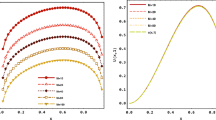Abstract
In this paper we present a numerical method for a time-fractional Black–Scholes equation, which is used for modeling the fractional structure of the financial market. The method is based on—first, discretization in time and then the weighted finite difference spatial approximation. Some properties of the spatial discretization are studied. The main difficulty (that originates from the non-local structure of the differential operator) of the algorithm is the impossibility to advance layer by layer in time. Numerical experiments are discussed.






Similar content being viewed by others
References
Achhdou Y, Pironneau O (2005) Computational methods for option pricing. SIAM, Philadelphia
Andersen L, Lipton, A (2012) Asymptotic for exponential Levy process and their volatility smile: survey and new results. arXiv:1206.6787v1 [q-fin.PR]
Elbeleze A, Kiliçman A, Taib B (2013) Homotopy perturbation method for fractional Black–Scholes European option pricing equations using Sumudu transform. Math Probl Eng. Article ID: 524852
Jumarie G (2008) Stock exchange fractional dynamics defined as fractional exponential growth driven by (usual) Gaussian white noise. Application to fractional Black-Scholes equations. Insur Math Econ 42:271–287
Jumarie G (2010a) Derivation and solutions of some fractional Black–Scholes equations in coarse-grained space and time. Application to Merton’s optima portfolio. Comput Math Appl 59:1142–1164
Jumarie G (2010b) Cauchy’s integral formula via the modified Riemann–Liouville derivative for analytic functions of fractional order. Appl Math Lett 23:1444–1450
Kumar S, Yildirim A, Khan Y, Jafari H, Sayevand K, Wei L (2012) Analytical solution of a fractional Black–Scholes European option pricing equation by using Laplace transform. J Fract Calc Appl 2(8):1–9
Liang J, Wang J, Zshang W, Qiu W, Ren F (2010) Option pricing of a bi-fractional Black–Merton–Scholes model with the Hurst exponent H in [1/2,1]. Appl Math Lett 10:859–863
Merton RC (1974) On the pricing of corporate debt: the risk structure of interest rates. J Financ 29:449–470
Miller KS, Ross B (1993) An introduction to the fractional calculus and fractional differential equations. Wiley, New York
Podlubny I (1999) Fractional differential equations. Academic Press, San Diego
Samarskii AA, Nikolaev ES (1978) Numerical methods for grid equations. Nauka, Moscow (in Russian)
Samko SG, Kilbas AA, Marichev OI (1987) Fractional integrals and derivatives. Theory and Applications. Gordon and Breach Science Publishers, London
Sevcovic D, Stehlikova B, Mikula K (2011) Analytical and numerical methods for pricing financial derivatives. Nova Science Publishers Inc, Hauppauge
Shen S, Liu F, Anh V, Turner I (2006) Detailed analysis of a conservative difference approximation for the time fractional diffusion equation. J Appl Math Comput 22(3):1–19
Song L, Wang W (2013) Solution of the fractional Black–Scholes option pricing model by finite difference method. Abstr Appl Anal 2013:1–10. Article ID 194286
Wang X-T (2010) Scaling and long-range dependence in option pricing I: pricing European option with transaction costs under the fractional Black–Scholes model. Physica A 389:438–444
Wang J, Liang J, Lv L, Qiu W, Ren F (2012) Continuous time Black–Scholes equation with transaction costs in subdiffusive fractional Brownian motion regime. Physica A 391:750–763
Wilmott P, Dewynne J, Howison S (1995) The mathematics of financial derivatives. Cambridge University Press, Cambridge
Acknowledgments
The authors are grateful to the anonymous referees for their fruitful comments that improved the content of this manuscript. This research was supported by the European Union under Grant Agreement number 304617 (FP7 Marie Curie Action Project Multi-ITN STRIKE—Novel Methods in Computational Finance) and Bulgarian National Fund of Science under Project I02/20-2014.
Author information
Authors and Affiliations
Corresponding author
Additional information
Communicated by Jorge Zubelli.
Rights and permissions
About this article
Cite this article
Koleva, M.N., Vulkov, L.G. Numerical solution of time-fractional Black–Scholes equation. Comp. Appl. Math. 36, 1699–1715 (2017). https://doi.org/10.1007/s40314-016-0330-z
Received:
Revised:
Accepted:
Published:
Issue Date:
DOI: https://doi.org/10.1007/s40314-016-0330-z
Keywords
- Fractional partial differential equations
- Black–Scholes equation
- Jumarie’s derivative
- Finite difference scheme
- Stability




